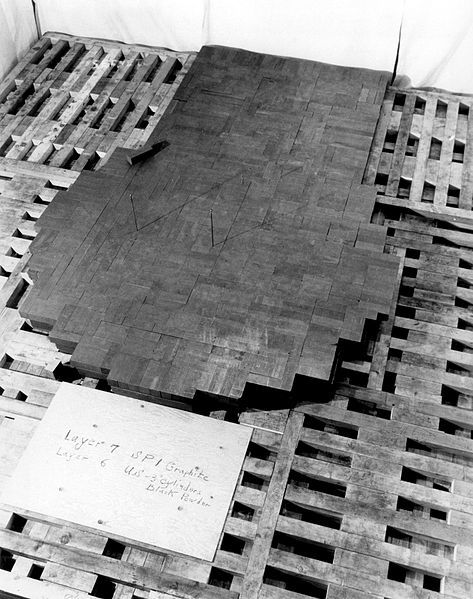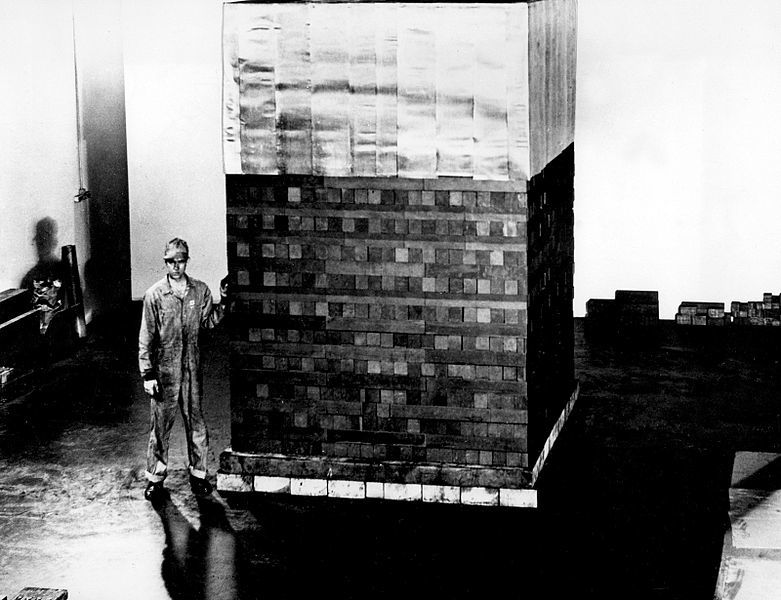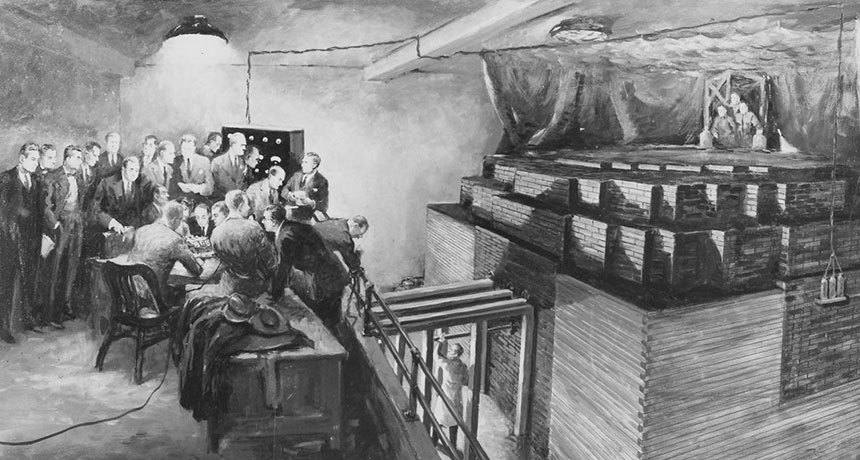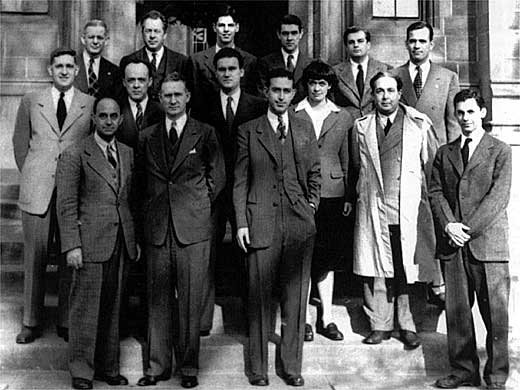First reaction of Nuclear Fission
Enrico Fermi left Italy in 1938 to receive the Nobel Prize for physics in Sweden. He never went back. He and his wife moved to the United States to escape Italy's increasing fascism and antisemitism.

Fermi, among others, realized that nuclear fission was accompanied by the release of colossal amounts of energy from the conversion of mass into energy (according to Einstein's mass-energy equation E=mc2). When scientists convinced President Roosevelt of this, Fermi was appointed to head a research team as part of a secret project to develop an atomic bomb in and the reactor's development was part of the Manhattan Project. Fermi's task, however, was to create a controlled nuclear reaction; that is, to split the atom without creating a deadly explosion.
Theoretically, it was possible. During fission, a fast-moving neutron splits an atom's nucleus, which results in the release of energy and additional neutrons. These ejected neutrons can split other nuclei, which release other neutrons to split still other nuclei, and so on: a self-sustaining chain reaction. If this chain reaction went too fast, it became an atomic explosion, but under control it could produce a steady flow of energy. (If the chain reaction started with uranium, it also created a byproduct, plutonium, a better fuel for a nuclear weapon.)
At the University of Chicago, Fermi worked with a team to find a way to control the chain reaction. He did this by setting up the equipment -- atomic pile -- so that he could insert a neutron-absorbing material into the midst of the fission process to slow it down or stop it altogether. He found that rods made of cadmium would absorb neutrons. If the chain reaction speeded up, the cadmium rods could be inserted to slow it down and could be removed to accelerate it again.
Fermi and Szilard still believed that enormous quantities of uranium would be required for an atomic bomb, and therefore concentrated on producing a controlled chain reaction. Fermi urged Alfred O. C. Nier (pioneered the development of mass spectrometry) to separate uranium isotopes for determination of the fissile component, and, on 29 February 1940, Nier separated the first uranium-235 sample, which, after being mailed to Dunning at Columbia, was confirmed to be the isolated fissile material. When he was working in Rome, Fermi had discovered that collisions between neutrons and neutron moderators can slow the neutrons down, and thereby make them more likely to be captured by uranium nuclei, causing the uranium to fission. Szilard suggested to Fermi that they use carbon in the form of graphite as a moderator. As a back-up plan, he considered heavy water. This contained deuterium, which would not absorb neutrons like ordinary hydrogen, and was a better neutron moderator than carbon; but heavy water was expensive and difficult to produce, and several tons of it might be needed. Fermi estimated that a fissioning uranium nucleus produced 1.73 neutrons on average. It was enough, but a careful design was called for to minimize losses. (Today the average number of neutrons emitted per fissioning uranium-235 nucleus is known to be about 2.4).
Chicago Pile 1 was encased within a balloon so that the air inside could be replaced by carbon dioxide. Anderson had a dark gray balloon manufactured by Goodyear Tire and Rubber Company. A 25-foot (7.6 m) cube-shaped balloon was somewhat unusual, but the Manhattan Project's AAA priority rating ensured prompt delivery with no questions asked. A block and tackle was used to haul it into place, with the top secured to the ceiling and three sides to the walls. The remaining side, the one facing the balcony from which Fermi directed the operation, was furled like an awning. A circle was drawn on the floor, and the stacking of graphite blocks began on the morning of 16 November 1942. The first layer placed was made up entirely of graphite blocks, with no uranium. Layers without uranium were alternated with two layers containing uranium, so the uranium was enclosed in graphite. Unlike later reactors, it had no radiation shielding or cooling system, as it was only intended to be operated at very low power.


By the end of 1942, the team was ready for its first test. The equipment was set up in a squash court at the University of Chicago. It was December 2. The moment was tense: if their theories and experiments until now proved wrong, they could blow up half of Chicago. A few of the rods were pulled out, and the reaction began. More rods came out. The reaction was self-sustaining. The team could increase or decrease the energy output by adjusting the rods. Fermi's idea had worked, and the first controlled, self-sustaining nuclear chain reaction -- the first controlled flow of energy from a source other than the Sun -- was achieved.

There were 49 scientists present. Although most of the S-1 Executive Committee was in Chicago, only Crawford Greenewalt was present, at Compton's invitation. Other dignitaries present included Szilard, Wigner and Spedding. Fermi, Compton, Anderson and Zinn gathered around the controls on the balcony, which was originally intended as a viewing platform. Samuel Allison stood ready with a bucket of concentrated cadmium nitride, which he was to throw over the pile in the event of an emergency. The startup began at 09:54. Walter Zinn removed the zip, the emergency control rod, and secured it. Norman Hilberry stood ready with an axe to cut the scram line, which would allow the zip to fall under the influence of gravity. While Leona Woods called out the count from the boron trifluoride detector in a loud voice, George Weil, the only one on the floor, withdrew all but one of the control rods. At 10:37 Fermi ordered Weil to remove all but 13 feet (4.0 m) of the last control rod. Weil withdrew it 6 inches (15 cm) at a time, with measurements being taken at each step.

The process was abruptly halted by the automatic control rod reinserting itself, due to its trip level being set too low. At 11:25, Fermi ordered the control rods reinserted. He then announced that it was lunch time.
The experiment resumed at 14:00. Weil worked the final control rod while Fermi carefully monitored the neutron activity. Fermi announced that the pile had gone critical (reached a self-sustaining reaction) at 15:25. Fermi switched the scale on the recorder to accommodate the rapidly increasing electrical current from the boron trifluoride detector. He wanted to test the control circuits, but after 28 minutes, the alarm bells went off to notify everyone that the neutron flux had passed the preset safety level, and he ordered Zinn to release the zip. The reaction rapidly halted. The pile had run for about 4.5 minutes at about 0.5 watts. Wigner opened a bottle of Chianti, which they drank from paper cups.
Compton notified Conant by telephone. The conversation was in an impromptu code:
Compton: The Italian navigator has landed in the New World.
Conant: How were the natives?
Compton: Very friendly.
With colleagues and other physicists looking on, Fermi produced the first self-sustaining nuclear chain reaction and the “new world” of nuclear power was born.

In the image above we have: Back row, from left: Norman Hilberry, Samuel Allison, Thomas Brill, Robert Nobles, Warren Nyer, and Marvin Wilkening. Middle row: Harold Agnew, William Sturm, Harold Lichtenberger, Leona Woods and Leo Szilard. Front row: Enrico Fermi, Walter Zinn, Albert Wattenberg and Herbert L. Anderson.
Since then, Fermi's theory has been expanded and refined. Nuclear reactors have been built in many countries to supply energy for military uses such as nuclear submarines and civilian uses such as ordinary electricity. But incidents through the years showed the dangers of the process and of its waste products, and nuclear power lost much of its original popularity.


REFERENCES
The University of Chicago. Available in: https://www.uchicago.edu/features/race_to_the_first_nuclear_chain_reaction/. Access in: 01/10/2018.
Public Broadcasting Service. Available in: http://www.pbs.org/wgbh/aso/databank/entries/dp42fe.html. Access in: 01/10/2018.
Wikipedia. Available in: https://en.wikipedia.org/wiki/Chicago_Pile-1. Access in: 01/10/2018.
Wikipedia. Available in: https://en.wikipedia.org/wiki/Enrico_Fermi. Access in: 01/10/2018.


























0 comments
Sign in or create a free account